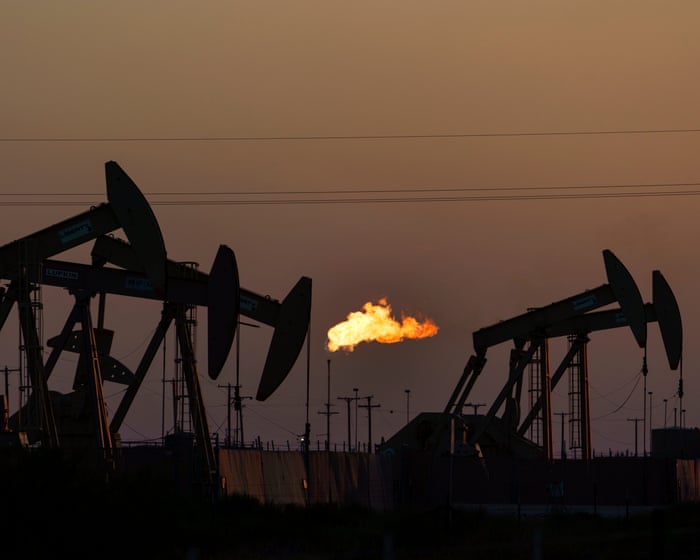For two years, global temperatures have consistently surpassed the 1.5°C warming limit set by the Paris climate agreement. UN Secretary-General António Guterres has warned that this overshoot will bring “devastating consequences.”
Scientists are particularly concerned that further warming could trigger irreversible tipping points, such as the widespread drying and die-off of the Amazon rainforest or the melting of the Greenland ice sheet. Once these thresholds are crossed, climate breakdown could spiral out of control.
For the UN and the world, minimizing—and if possible, reversing—this temperature overshoot must now be the priority. However, transitioning the world’s energy systems away from fossil fuels is a slow process, taking decades we no longer have. Some scientists believe the solution lies in addressing another powerful greenhouse gas: methane.
“Cutting methane is the single most important strategy to slow near-term warming,” says Durwood Zaelke, president of the Institute for Governance and Sustainable Development and a longtime advocate for methane action. “In fact, it’s the only strategy with a real chance of working. Reducing carbon dioxide is like running a marathon, but cutting methane is a sprint.”
Methane, the main component of natural gas used for fuel worldwide, comes from both natural and human-made sources. These include leaky oil and gas infrastructure, livestock, and the decomposition of organic matter. While methane stays in the atmosphere for only about 20 years—far less than carbon dioxide—it traps about 80 times more heat during that time.
Scientists estimate that methane alone has caused at least a third of recent global warming. New satellites and detection systems have revealed that many countries have been significantly underreporting their methane emissions. In fact, methane levels in the atmosphere have been rising sharply, even as carbon dioxide emissions have slowed.
Reducing methane emissions would give the planet crucial breathing room, delaying the worst impacts of climate breakdown while the shift to clean energy accelerates. A 40% cut in methane could lower global temperatures by about 0.3°C over the next decade, and by as much as 0.5°C by 2050 with further reductions. If the world hopes to limit warming to 1.5°C above pre-industrial levels, action on methane is essential.
“It’s the rocket in the pocket,” says Paul Bledsoe, a former climate adviser in the Clinton White House. “Reducing methane is effective and cheap—two-thirds of the necessary cuts in the energy sector could be achieved at zero net cost.”
A study published in October in the journal Science found that significant methane reductions could delay key tipping points. For example, it could lower the risk of Amazon rainforest dieback by about 8% and reduce disruption to the Indian monsoon by about 13%.
The study also concluded that cutting methane pays for itself three times over—or six times over when health benefits are included. Reducing methane emissions by a third by 2030 would bring about $1 trillion in annual benefits to the global economy. Simon Dietz, a professor at the London School of Economics and co-author of the study, says, “The benefits of global methane action far outweigh the costs, making the economic case clear. It’s not only feasible but economically compelling.”
Despite this, progress has been slow. More than 150 countries committed under the 2021 Global Methane Pledge to cut methane emissions by 30% by 2030, compared to 2020 levels. However, major emitters like China, India, and Russia are not part of the pledge, and the U.S., under Donald Trump, now appears unlikely to meet its commitments.
There have been some efforts to address the issue. In a 2023 agreement with the U.S. under President Biden, China committed to targeting its methane emissions. Whether this will be upheld now that Trump has returned to the White House remains to be seen.China at COP30.
Last year, the EU introduced new methane regulations that require European companies to cut methane emissions and impose strict monitoring and reporting rules on imported gas. This means gas from other countries must meet high standards, such as avoiding routine venting and flaring.
Svitlana Romanko, founder and executive director of Razom We Stand, said: “By enforcing transparency and accountability across the gas supply chain, including imports, this regulation will reveal the hidden climate costs of fossil gas and expose the true environmental impact of unaccountable suppliers like Russia. This will help EU consumers and policymakers make cleaner, more ethical choices and speed up the move away from fossil fuels.”
Countries aiming to reduce methane have many simple and sometimes profitable options. Capping shale gas wells is low-cost and uses well-established, widely available technology. Fixing leaks from oil and gas platforms, pipelines, and other infrastructure can save money, as the captured gas can be sold. Ending wasteful venting and flaring is an easy win: while it was once routine for safety reasons to prevent methane buildup and explosions, long-standing technology now makes this unnecessary. The best producers are 100 times more efficient than average, and others can follow their lead.
Tommaso Franci of the campaign group Amici della Terra said: “Methane emissions across the supply chain indicate poor environmental and operational practices in the fossil fuel industry. Reducing methane emissions in the energy sector is the most effective and quickest way to cut greenhouse gases in the short term.”
While there are positives, the negatives are significant. The U.S. is one of the largest global sources of methane, especially from its many shale gas fracking sites. Implementing better practices in the industry would be cheap and easy and could alleviate many social issues for people living near wells.
With Trump in the White House, enforcement is unlikely—rules developed under Biden have been put on hold. Bledsoe believes the private sector will take action regardless. “They know that reducing emissions is part of their social license to operate,” he said. “And new detection technology will expose those who lag behind.”
An open-pit coal mine in China’s Inner Mongolia province. China’s coal mines alone account for about a tenth of global energy-related methane leaks. No such pressure will be applied to Russia, which has some of the largest methane sources from oil and gas facilities. “We know they engage in massive venting and flaring, and their infrastructure is leaky. But they don’t provide any data,” said Bledsoe.
Abandoned coal mines are another major source, according to a recent International Energy Agency study. China’s coal mines are responsible for roughly 10% of global energy-related methane leaks. “It’s a double whammy: the CO2 from burning coal and the methane escaping,” Bledsoe noted.
Sabina Assan, a senior analyst at the think tank Ember, says: “The technologies to mitigate coal mine methane…”The solutions to reduce methane are already available. Now, it’s time for companies and governments to put these solutions into action and bring emissions down. Zaelke is calling for a global methane agreement that would require emissions cuts and the adoption of best practices across the energy industry worldwide. Mia Mottley, the influential Prime Minister of Barbados, also supports this idea.
Zaelke warns, “There are backsliders, so unless we turn promises into legally binding commitments, we won’t slow warming in time.”
The likelihood of such an agreement being signed at Cop30 is low, but many countries are becoming more open to discussing methane and acknowledge that current pledges aren’t making progress fast enough. Most nations that have developed national climate plans—known as nationally determined contributions (NDCs)—have included measures to address methane.
While fixing leaky energy infrastructure is the quickest, cheapest, and most direct way to cut methane emissions, agriculture, waste, and livestock account for about 40% of human-made methane and cannot be overlooked. A recent report by Foodrise, Friends of the Earth US, Greenpeace Nordic, and the Institute for Agriculture and Trade Policy found that the world’s 45 largest meat and dairy companies produced over 1 billion tonnes of greenhouse gas emissions—more than Saudi Arabia.
Yushu Xia, an assistant research professor at Columbia University, points out that there are methods to reduce methane from livestock and agriculture. For example, improving water, fertilizer, and soil management in rice production—since paddy fields are major methane sources—and enhancing feeding and breeding practices for livestock, including using feed additives and potentially gene editing. She adds, “Better management of soils, animals, and crops that lowers emissions often brings additional benefits like improved soil health and reduced pollution.”
Diets will also need to shift away from high red meat consumption, which is a significant health issue in developed countries. Kari Hamerschlag, deputy director of food and agriculture at Friends of the Earth, states, “If governments are serious about meeting climate goals, they can no longer ignore the impact of industrial meat and dairy. Binding agricultural emissions targets, full supply-chain reporting, and support for a just transition to agroecology and more plant-based food systems are essential.”
Frequently Asked Questions
Of course Here is a list of helpful and clear FAQs about the role of reducing methane emissions in preventing a climate crisis
BeginnerLevel Questions
1 What is methane and why is it a problem for the climate
Methane is a powerful greenhouse gas that comes from sources like livestock landfills and fossil fuel production Its a problem because it traps over 80 times more heat in the atmosphere than carbon dioxide over a 20year period significantly accelerating global warming
2 How is methane different from carbon dioxide
The main difference is potency and lifespan Methane is much more effective at trapping heat than CO2 but it stays in the atmosphere for a much shorter time This means reducing methane has a faster more immediate impact on slowing warming
3 Can cutting methane emissions really help stop a climate crisis
Yes significantly Because methane is so potent and shortlived cutting its emissions is one of the fastest and most effective ways to slow the rate of global warming in the near term buying us crucial time to tackle longerterm CO2 emissions
4 What are the main sources of methane that humans are responsible for
The primary humancaused sources are
Agriculture Especially from livestock and rice cultivation
Fossil Fuels Leaks from oil and gas production storage and transport
Waste Decomposing organic matter in landfills
Intermediate Advanced Questions
5 What does potent but shortlived actually mean for climate action
It means that while a single methane emission causes intense warming it disappears from the atmosphere relatively quickly Therefore when we stop a methane leak we see a cooling effect within a decade or two This rapid payoff is key for preventing climate tipping points
6 What are the cobenefits of reducing methane emissions
Reducing methane has fantastic bonus benefits
Improved Public Health It reduces groundlevel ozone which can cause asthma and other respiratory illnesses
Economic Savings Captured methane from oilgas leaks or landfills can be sold as natural gas creating revenue
Enhanced Food Security In agriculture better manure management can improve soil health and productivity




